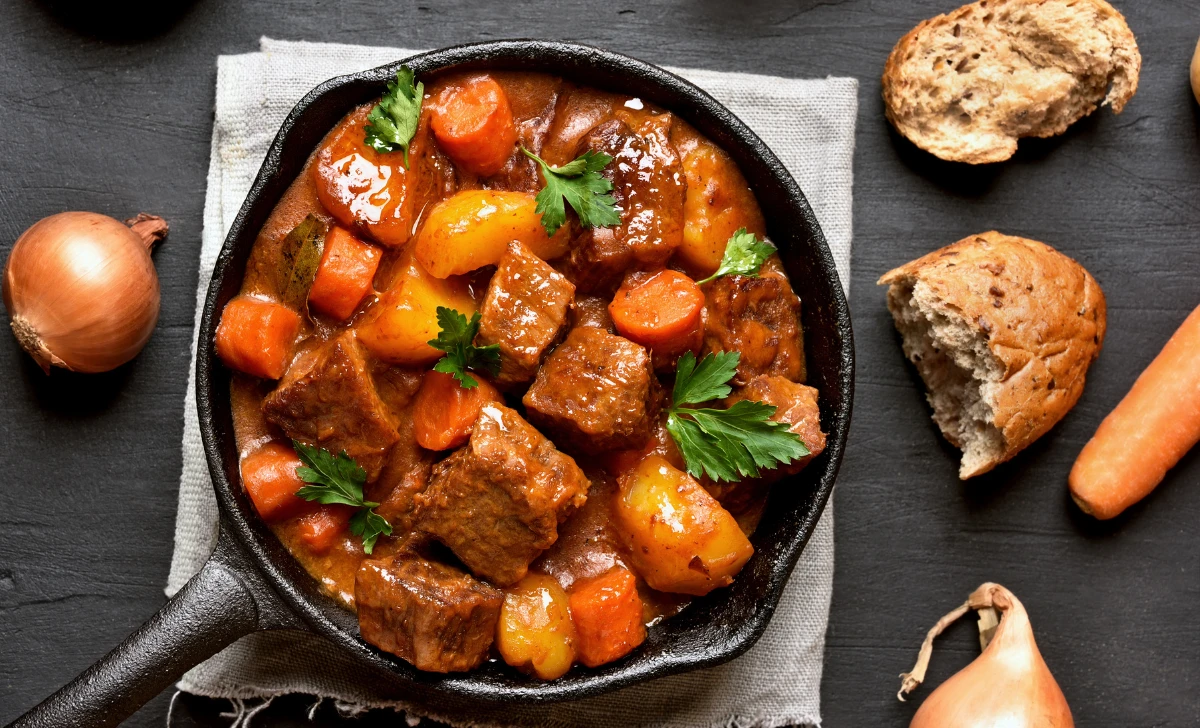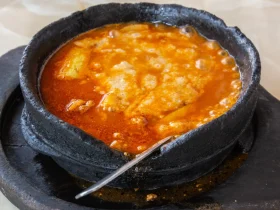Hey there, foodies! Today, we’re diving into the heartwarming world of beef stew. Picture this: tender chunks of beef, paired with vibrant vegetables, simmered to perfection in a rich, flavorful broth. Ah, the comfort of a steaming bowl of beef stew on a chilly day! In this article, we’ll explore the secrets of creating the ultimate beef stew that will have your taste buds dancing with joy.
[ez-toc]
History
Once upon a time, in the heart of Europe, beef stew emerged as a humble peasant dish, born out of necessity and resourcefulness. Its origins can be traced back to medieval times, where communities had limited access to ingredients and had to make the most of what they had.
Back then, beef stew was a simple concoction, prepared with tough and less desirable cuts of beef. These cuts were often tough to chew and required lengthy cooking to become tender. However, the resourceful cooks of the time discovered that slow cooking these tougher meats with vegetables and herbs yielded a hearty and comforting dish.
As time went on, beef stew evolved and spread across various regions and cultures. Each place added its own unique twist, using locally available ingredients and traditional cooking techniques. In colder climates, hearty root vegetables like carrots and potatoes became staples in the stew, adding substance and flavor. In warmer regions, cooks experimented with a variety of herbs and spices to infuse the stew with regional flair.
The popularity of beef stew continued to grow, and by the 19th century, it had become a beloved dish in many households. With the rise of culinary arts and the availability of better cuts of beef, the recipe transformed into a more refined and versatile dish.
In the United States, beef stew became a symbol of comfort and nostalgia during the Great Depression. Families relied on this economical and filling dish to stretch their food supplies and make the most of what they had.
Over the years, the beef stew recipe has been passed down through generations, with each family adding its own secret ingredients and cooking tips. With the advent of modern kitchen appliances, like the slow cooker, making beef stew became even more accessible and convenient.
Today, beef stew has transcended its humble beginnings and has earned a place on restaurant menus and in gourmet cookbooks. It has become a cherished comfort food, loved by people of all ages and backgrounds. Whether enjoyed in the comfort of home or served in a fine dining establishment, beef stew continues to warm hearts and bring joy to those who savor its rich and savory flavors.
As we look back at the history of this beloved dish, we are reminded of the power of food to bring people together, to create traditions, and to preserve the essence of a culture. So, the next time you savor a steaming bowl of beef stew, take a moment to appreciate the centuries of culinary heritage that have led to the delightful flavors dancing on your taste buds.
Time
| Step | Time Required |
|---|---|
| Choosing the Right Cut of Beef | 10 minutes |
| Gathering the Ingredients | 20 minutes |
| Prepping for Cooking | 15 minutes |
| Cooking Methods | Variable |
| Secret Ingredients and Flavor Enhancers | 5 minutes |
| The Slow-Cooking Process | 2-4 hours |
| Thickening the Stew | 5 minutes |
| Serving and Pairing | 5 minutes |
| Storing and Reheating | 5 minutes |
| Variations on the Classic Recipe | 10 minutes |
| Beef Stew: A Family Tradition | 5 minutes |
| Health Benefits of Beef Stew | 5 minutes |
| Cooking Tips and Hacks | 10 minutes |
| Total Preparation and Cooking Time | 2 hours + |
Please note that the total preparation and cooking time may vary based on the chosen cooking method (slow cooker, stovetop, or Dutch oven) and the size of the beef stew batch. Slow cooking on low heat will take longer but will result in a more tender and flavorful stew. The time provided above is an estimate and does not include marinating time if applicable.
Ingredients
| Ingredients | Quantity for 2 Servings |
|---|---|
| Beef (Chuck Roast or Brisket) | 1 pound |
| Carrots | 2 medium-sized |
| Potatoes | 2 medium-sized |
| Onion | 1 medium-sized |
| Garlic cloves | 2 |
| Fresh Thyme | 1 sprig |
| Fresh Rosemary | 1 sprig |
| Bay Leaf | 1 |
| Red Wine | 1/2 cup |
| Tomato Paste | 2 tablespoons |
| Worcestershire Sauce | 1 tablespoon |
| Soy Sauce | 1 tablespoon |
| Beef Stock or Broth | 2 cups |
| All-Purpose Flour or Cornstarch | 2 tablespoons |
| Olive Oil | 2 tablespoons |
| Salt and Pepper | To taste |
These ingredients are the foundation for a delicious and hearty beef stew that will leave you and your dining partner completely satisfied. Feel free to adjust the quantities based on your personal preferences and tastes. Enjoy your culinary adventure!
Directions
Step 1: Choosing the Right Cut of Beef
- Select a high-quality chuck roast or brisket for the best results. Trim any excess fat and cut the meat into bite-sized chunks.
Step 2: Gathering the Ingredients
- Wash and peel the carrots and potatoes. Cut them into chunks, keeping them relatively uniform in size.
- Peel and chop the onion and garlic cloves.
- Gather the fresh thyme and rosemary sprigs, along with the bay leaf.
- Measure out the red wine, tomato paste, Worcestershire sauce, soy sauce, and beef stock or broth.
- Keep the all-purpose flour or cornstarch ready for thickening the stew.
Step 3: Prepping for Cooking
- Season the beef chunks generously with salt and pepper, ensuring even distribution of the seasoning.
- In a large pot or Dutch oven, heat one tablespoon of olive oil over medium-high heat.
- Add the seasoned beef and sear it on all sides until nicely browned. Remove the beef from the pot and set it aside.
Step 4: Cooking Methods
- Option 1: Slow Cooker Convenience
- Transfer the seared beef, carrots, potatoes, chopped onion, garlic, thyme, rosemary, and bay leaf into a slow cooker.
- Pour in the red wine, tomato paste, Worcestershire sauce, and soy sauce.
- Add the beef stock or broth to cover all the ingredients.
- Cook on low heat for 6 to 8 hours or on high heat for 3 to 4 hours, until the beef is fork-tender.
- Option 2: Simmering on the Stovetop
- In the same pot used for searing the beef, add the chopped onion and garlic. Sauté until they become translucent.
- Return the seared beef to the pot, along with the carrots, potatoes, thyme, rosemary, and bay leaf.
- Pour in the red wine, tomato paste, Worcestershire sauce, and soy sauce.
- Add the beef stock or broth to cover all the ingredients.
- Bring the stew to a boil, then reduce the heat to low and let it simmer for 2 to 3 hours, stirring occasionally, until the beef is tender.
- Option 3: Embracing the Classic Dutch Oven
- Preheat your oven to 325°F (160°C).
- Return the seared beef to the pot, along with the chopped onion, garlic, carrots, potatoes, thyme, rosemary, and bay leaf.
- Pour in the red wine, tomato paste, Worcestershire sauce, and soy sauce.
- Add the beef stock or broth to cover all the ingredients.
- Cover the Dutch oven with a lid and place it in the preheated oven.
- Cook for 2 to 3 hours, until the beef becomes tender.
Step 5: Secret Ingredients and Flavor Enhancers
- Remove the bay leaf, thyme sprig, and rosemary sprig from the stew.
- Taste the stew and adjust the seasoning with salt and pepper if needed.
- For added richness, you can also stir in a pat of butter at this stage.
Step 6: Thickening the Stew
- In a small bowl, mix the all-purpose flour or cornstarch with a splash of water until smooth to create a slurry.
- Stir the slurry into the stew and let it simmer for a few more minutes until the stew thickens slightly.
Step 7: Serving and Pairing
- Ladle the flavorful beef stew into serving bowls.
- Garnish with fresh thyme or parsley if desired.
- Serve with crusty bread or fluffy rice as the perfect side dishes.
- Pair the stew with a glass of red wine for a delightful dining experience.
Equipment Required
Nutrition Information
| Nutrient | Per Serving (2-person serving) |
|---|---|
| Serving Size | 1 bowl (approximately 1 1/2 cups) |
| Calories | 400 kcal |
| Total Fat | 18g |
| – Saturated Fat | 6g |
| – Trans Fat | 0g |
| Cholesterol | 100mg |
| Sodium | 900mg |
| Total Carbohydrates | 25g |
| – Dietary Fiber | 5g |
| – Sugars | 6g |
| Protein | 35g |
Note: The nutrition information is an estimate and may vary based on the specific ingredients used and any customizations made to the recipe. It is always best to calculate the nutrition information based on the exact ingredients and quantities used in your preparation.
Tips
- Choose the Right Beef Cut: Opt for well-marbled cuts like chuck roast or brisket, as they become tender and flavorful during slow cooking.
- Searing for Flavor: Take the time to sear the beef before simmering. This step locks in juices and adds a depth of caramelized flavor to the stew.
- Consistent Vegetable Cuts: Cut the vegetables into uniform sizes to ensure even cooking and a balanced texture.
- Fresh Herbs vs. Dried: While fresh herbs add more vibrant flavors, dried herbs can also be used in a pinch. Remember to use them in smaller quantities, as their flavors are more concentrated.
- Choosing the Cooking Method: Each cooking method (slow cooker, stovetop, or Dutch oven) has its merits. The slow cooker is convenient, the stovetop gives more control, and the Dutch oven creates a rustic taste.
- Layering Flavors: Build layers of flavors by sautéing the onions and garlic before adding the beef. This enhances the overall taste of the stew.
- Wine Selection: Use a red wine that you would enjoy drinking, as it contributes significantly to the stew’s richness. Avoid sweet wines for this recipe.
- Low and Slow: For the best results, let the stew simmer on low heat for an extended period. This slow cooking allows flavors to meld and the beef to become tender.
- Thickening Options: Choose either all-purpose flour or cornstarch to thicken the stew. For a gluten-free option, go with cornstarch.
- Let it Rest: After cooking, allow the stew to rest for a few minutes before serving. This gives the flavors a chance to fully develop.
Pros & Cons
| Pros | Cons |
|---|---|
| ✅ Comforting and flavorful | ❌ Longer cooking time |
| ✅ Nutritious and balanced | ❌ Requires some prep work |
| ✅ Versatile; customizable | ❌ Not suitable for vegetarians |
| ✅ Great for leftovers | ❌ High in sodium |
| ✅ Perfect for family gatherings | ❌ May be challenging for novice cooks |
Conclusion
Congratulations, aspiring chefs! You’ve journeyed through the tantalizing world of Beef Stew, and now it’s time to savor the rewards of your culinary adventure. With its comforting and flavorful allure, this recipe promises a heartwarming delight that will warm not just your body but also your soul.
Embrace the versatility of this dish as you customize it to suit your taste buds and dietary preferences. Whether you choose the slow cooker for convenience, the stovetop for precise control, or the Dutch oven for a rustic touch, the result will be a symphony of flavors that will leave you yearning for more.
The balanced nutrition, packed with protein, fiber, and essential nutrients, ensures that your taste buds aren’t the only ones rejoicing. It’s a filling and nutritious meal that will keep you satisfied and energized.
Picture this: a cozy family gathering, laughter filling the air, and the aromatic fragrance of beef stew wafting from the kitchen. Or perhaps it’s a peaceful evening, just you and a loved one, relishing the perfect bowl of stew to melt away the day’s stress. This recipe brings joy and nostalgia, making every moment spent preparing and savoring it a memorable experience.
So don your aprons, grab your cooking utensils, and let the magic begin! Trust your instincts, experiment with variations, and create your culinary masterpiece. The satisfaction of seeing your loved ones savor every spoonful or indulging in a bowl all to yourself will be unparalleled.
In the kitchen, as in life, the journey is as important as the destination. Embrace the process, celebrate the nuances, and let the warmth of Beef Stew be the thread that weaves beautiful memories into your culinary tapestry.
So, what are you waiting for? Let the simmering flavors and nourishing goodness of Beef Stew envelop you in a culinary embrace. Take a leap into the world of comfort and delight. It’s time to create your own epicurean tale with this soul-soothing recipe. Bon appétit! 🍲😋
Facts
- 1. The Medieval Roots 🏰
- 📜 Fact: Beef stew’s history dates back to medieval times when resourceful cooks created this dish to make tough cuts of beef tender and flavorful.
- 🍴 Fun Fact: The medieval version of beef stew often included unusual ingredients like dried fruits and spices to enhance the flavors.
- 2. Budget-Friendly Brilliance 💰
- 💡 Fact: Beef stew became a beloved dish during the Great Depression as families relied on its economical nature to stretch food supplies.
- 🍴 Fun Fact: In the Great Depression era, creative home cooks added ingredients like potatoes and carrots to bulk up the stew and make it more filling.
- 3. The Magic of Slow Cooking ⏳
- 🔮 Fact: The slow-cooking method allows the stew’s flavors to meld beautifully and the beef to become fork-tender, resulting in a comforting masterpiece.
- 🍴 Fun Fact: Slow cooking not only enhances the taste but also fills your home with an irresistible aroma, creating a cozy ambiance.
- 4. An International Affair 🌍
- 🌐 Fact: Beef stew has traveled the world, with each region adding its own unique twist. From French Boeuf Bourguignon to Hungarian Goulash, there’s a stew for every palate.
- 🍴 Fun Fact: In Mexico, beef stew is known as “carne guisada” and often features spicy chilies and tomatoes, reflecting the country’s vibrant culinary heritage.
- 5. Stew-Perb Leftovers 🍽️
- ♻️ Fact: Beef stew is a gift that keeps on giving! Its flavors intensify the next day, making it a delightful option for leftovers.
- 🍴 Fun Fact: In some cultures, leftover beef stew is creatively repurposed into delicious fillings for savory pies or hearty hand pies, ensuring nothing goes to waste.
FAQ’s
Can I make this beef stew recipe in a slow cooker?
Absolutely! Slow cooking is a fantastic option for this recipe. Simply follow the instructions for the slow cooker cooking method in the article, and let the stew simmer to perfection while you go about your day.
Can I use different cuts of beef for the stew?
Certainly! While chuck roast and brisket are classic choices, you can explore other cuts like stewing beef or even boneless short ribs. Just ensure they are suitable for slow cooking and have enough marbling for tenderness.
Can I freeze the leftovers?
Absolutely! Beef stew freezes well, making it a convenient option for meal prep. Allow the stew to cool completely, transfer it into airtight containers, and freeze for up to three months. Thaw in the refrigerator overnight before reheating.
Is there a way to make this stew gluten-free?
Yes, indeed! To make the stew gluten-free, use cornstarch instead of all-purpose flour for thickening. Simply mix the cornstarch with water and stir it into the stew to achieve a luscious texture.
How can I adjust the recipe for a larger group of people?
Scaling up the recipe is easy! Just double or triple the ingredients accordingly and use a larger pot or slow cooker to accommodate the increased quantity.
Can I make this recipe ahead of time?
Absolutely! Beef stew tastes even better the next day as the flavors continue to meld. You can make it a day in advance, refrigerate it, and gently reheat it before serving.
Can I omit the red wine from the recipe?
Yes, you can omit the red wine if you prefer a non-alcoholic version. You can replace it with additional beef broth or simply increase the amount of water or broth.
What side dishes go well with beef stew?
Beef stew pairs wonderfully with crusty bread, buttered rolls, or fluffy rice. You can also serve it with mashed potatoes or a side of steamed greens for a balanced meal.
Can I add other vegetables to the stew?
Absolutely! Feel free to get creative with the vegetables. Mushrooms, green beans, peas, or bell peppers are excellent additions that can add even more depth to the dish.
Can I cook the stew on high heat for a shorter time?
While cooking on high heat will reduce the cooking time, we recommend opting for the low and slow method. Slow cooking allows the flavors to develop fully and ensures the beef becomes tender and succulent. Patience is rewarded with a more flavorful stew!












Leave a Review